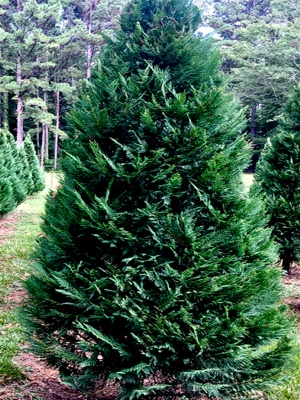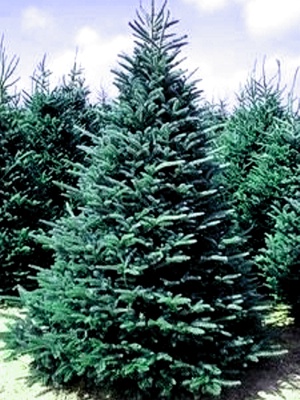Wilderwood Christmas Trees
Leyland Cypress

The main variety of farm-grown tree at Wilderwood is the Leyland Cypress. Known for it's longevity and shedless needles, Leyland Cypress deliver the fresh touch and smell of a live tree without the hassle of shedding needles. Give them ample water and proper care, and this tree will easily stay fresh through the entire Christmas season and into the new year! Leylands are beautiful trees with soft, dark green foliage. Since they are not in the Pine or Fir families, they do not produce sap or pollen, enabling many allergy and asthma sufferers to enjoy a real tree in their homes without ill effects.
Fraser Firs

Fraser Firs have strong, slightly up-turned branches, blue green foliage, a pleasant aroma, and good needle-retention. Because they require cooler summer temperatures and higher altitudes, they do not grow here in Alabama. However, we work with farms in North Carolina to carry pre-cut Fraser Firs for families who prefer this variety of Christmas tree.
Our pre-cut Fraser Firs are always kept in water containers, assuring you the freshest pre-cut trees anywhere.
![]()
Caring for Your Tree
When your Christmas tree is cut, more than half its weight is water. With proper care, your tree will stay green and fresh throughout the holiday season. Below are a few tips that will help in caring for your Christmas tree.
- Your tree needs water! Display you tree in a traditional reservoir type stand to maintain freshness.
- To display indoors, use a stand with an adequate water capacity. Generally, the stand should provide 1 quart of water per inch of stem diameter.
- Use a stand that fits your tree. Avoid whittling the sides of the trunk down to fit a stand. The outer layers of wood are the most efficient in taking up water and should not be removed.
- Once home, place your tree in water as soon as possible. Most species can go 6 to 8 hours after cutting the trunk and still take up water. Don’t bruise the cut surface or get it dirty. If needed, trees can be temporarily stored for several days in a cool location. Place the trunk in a bucket that is kept full of water.
- Upon taking it home, if you do not put your tree directly in a stand with water or a water bucket, make a fresh cut to remove about ½” from the base of the trunk before putting it in the stand. Make the cut perpendicular to the stem axis. Don’t cut the trunk at an angle, or into a v-shape, which makes it far move difficult to hold the tree in the stand and also reduces the amount of water available to the tree. Drilling a hole in the base of the trunk does NOT improve water uptake.
- The temperature of the water used to fill the stand is not important and does not affect water uptake.
- Check the stand daily to make sure that the level of water does not go below the base of the tree. With many stands, there can still be water in the stand even though the base of the tree is no longer submerged in water.
- Keep trees away from major sources of heat (fireplaces, heaters, heat vents, direct sunlight). Lowering the room temperature will slow the drying process, resulting in less water consumption each day.
- Using lights that produce low heat, such as miniature lights, will reduce drying of the tree.
- Always inspect light sets prior to placing them on the tree. If worn, replace with a new set.
- Do not overload electrical circuits.
- Always turn off the tree lights when leaving your house or when going to bed.
- Monitor the tree for freshness. If the tree becomes very dry, remove it from the house.
- Visit the Tree Recycling page to find a recycling program near you.
- Never burn any part of a Christmas tree in a wood stove or fireplace.
Prepared by Dr. Gary Chastagner and Dr. Eric Hinesley; edited by the National Christmas Tree Association.
![]()